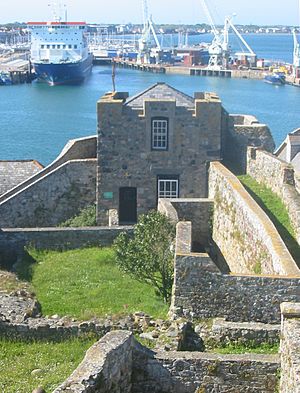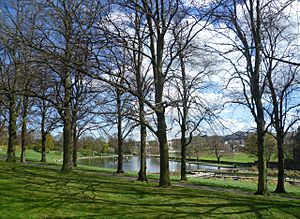Peter Meutas facts for kids
Peter Meutas (died 1562) was an English courtier and soldier who served King Henry VIII, King Edward VI, and Queen Elizabeth I. He was known for his skills with firearms and his diplomatic work.
Contents
Early Life and Family
Peter Meutas was the grandson of John Meutas, who was a French secretary for King Henry VII. Peter's parents were Philip Meutas and Elizabeth Foxley.
Serving the King
Peter Meutas worked at the court of King Henry VIII. He was a "gentleman of the Privy Chamber," which meant he was a close attendant to the King. He was very good with handguns and was described as tall and strong.
Meutas was also a "Gentleman Usher," receiving a salary for his service. He and other courtiers formed a group called the Fraternity of Saint George. This group focused on archery and handguns, and it is thought to be an early version of the Honourable Artillery Company, a famous military group.
Meutas spoke French well. In 1539, King Henry VIII gave Meutas and his wife, Jane, land in Essex, including the area of Stratford Langthorne Abbey. A wall near the river there was even known as "Mewtas's Wall."
Diplomatic Missions
In 1538, Henry VIII was thinking about marrying Mary of Guise, a French noblewoman. Thomas Cromwell, a powerful advisor to the King, sent Peter Meutas to meet her and ask for her portrait. Meutas's report encouraged the King, who then sent other artists to paint her.
In 1539, Meutas and his wife were part of the royal group that met Anne of Cleves when she arrived in England to marry Henry VIII. Meutas also worked as a spy in Normandy, France, in 1546.
Fighting in Scotland

Peter Meutas was an important soldier during the "Rough Wooing," a war between England and Scotland in the 1540s.
In May 1544, he led a group of soldiers called "hagbutters" (who used early firearms) during the Burning of Edinburgh. His soldiers helped capture Scottish cannons during a fight near Inverleith. The English commander praised Meutas's men for their "honest service." Because of his bravery, Meutas was made a knight on May 18, 1544.
Later that year, Meutas sailed from Bristol to try and help Matthew Stewart, 4th Earl of Lennox take Dumbarton Castle in Scotland. They captured some islands but were not successful at Dumbarton. Meutas then brought news of this to Queen Catherine Parr and later to King Henry VIII in France.
Governor of Guernsey
In 1545, Sir Peter Meutas was made Governor of Guernsey and Castle Cornet, a fortress. He held this important job until 1553. He oversaw the building of new defenses, and a tower at Castle Cornet was even named the "Mewtis Bulwark." A cannon made for Guernsey during his time as governor still exists today.
In 1547, after King Henry VIII died, Meutas was sent to France to share the news.
He returned to Scotland in September 1547. His soldiers helped capture and demolish Thornton Castle and set Innerwick Castle on fire before the battle of Pinkie. His "hacquebuttes" (soldiers with firearms) also fought at Pinkie.
Under Queen Mary I and Queen Elizabeth I
During the reign of Mary I of England, Sir Peter Meutas was imprisoned in 1555 because he did not support the Queen. His offices in Guernsey were given to someone else.
In 1559, when Elizabeth I became Queen, Sir Peter Meutas was recommended as a good diplomat for missions in France. He was trusted by both Elizabeth I and Mary, Queen of Scots.
In 1561, Meutas carried letters from Elizabeth I to Mary, Queen of Scots, who had just returned to Scotland from France. He was involved in talks about the 1560 Treaty of Edinburgh. This was a very sensitive discussion because it involved who would become the next ruler of England. Mary, Queen of Scots, trusted Meutas and even gave him a valuable gold chain.
Mary was keen to know if her answers pleased Elizabeth. Elizabeth was not fully happy with Mary's refusal to agree to the treaty. Mary also asked Meutas to request a painted portrait of Elizabeth.
Sir Peter Meutas died in Dieppe, France, in September 1562, while on another diplomatic mission to Paris.
Family Life
Sir Peter Meutas was married twice. His first wife was Jane Ashley, who died around 1551. His second wife was also named Jane, and she died in 1577.
He had several children, including:
- Henry Meutas (1526-1588)
- Thomas Meutas
- Hercules Meutas
- Frances Meautas, who was a Maid of Honour to Queen Elizabeth I.
Images for kids
-
Mary, Queen of Scots, trusted Meutas as a diplomat in a sensitive negotiation.




